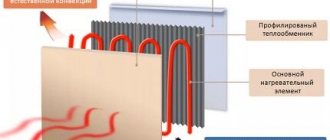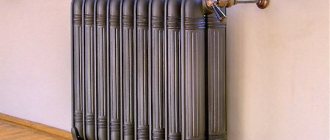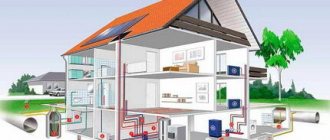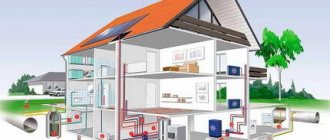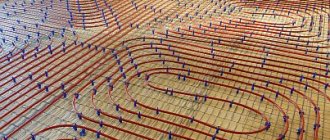If standard heating devices are not able to provide a comfortable atmosphere in the home, then you have to purchase additional heat sources. Recently, infrared heating panels have gained popularity. They are compact in size and demonstrate high operating efficiency. Automation allows you to control the basic parameters of the operation of such devices.
A fairly compact heating source
Infrared radiation: nature and properties
Infrared radiation is included in the spectrum of electromagnetic radiation from the Sun. With the help of this part of the spectrum, heat is transferred directly to the earth, various objects and bodies, which in turn heat the air. It’s not for nothing that these rays are also called heat rays.
Solar radiation spectrum
But not only the Sun is a source of heat rays. As we have already said, any surface heated to a certain temperature emits infrared waves. The human body is no exception, the length of heat rays is approximately 10 microns (see Fig. 1). It is waves of this length that are the most favorable for humans; the human body perceives them as “its own.” Therefore, infrared rays have found successful use in therapeutic and preventive medicine. They help strengthen the immune system and contribute to the overall strengthening of all vital systems of the body. Under the influence of heat rays, blood circulation is stimulated, the supply of human body cells with necessary substances is improved, metabolism and regenerative processes are accelerated. This list can be continued for a very long time.
How do electric infrared panels work?
We found out that infrared rays are carriers of heat, which is so necessary for the normal functioning of the human body. Now let's figure out how such panels help provide heat to the entire house.
An electric infrared panel is a ceramic plate containing a resistive heating element. When current passes through such an element, it heats up and the heat is transferred to the ceramic plate. But why ceramics?
Ceramic infrared panels in the interior
Firstly, it has a high heat capacity. On the one hand, this is a minus, since it takes from 10 to 20 minutes for the surface of the stove to heat up to operating temperature. On the other hand, this is a big plus, because such material promotes uniform heating of the entire surface of the device and better distribution of rays in the room. In addition, after turning off the power, the surface cools down to room temperature within another 30-40 minutes (which cannot be said about water heating radiators or other heating devices).
Secondly, ceramics are a good choice for aesthetic reasons. We will talk about the variety of types of panels below, but for now we will only say that their range will allow you to choose the most suitable model for your interior.
In addition to thermal radiation, ceramic panels provide 30% heating by convection. This is achieved thanks to the presence of a radiator grille on the panel. This design allows you to install the device under a window to form a “thermal barrier” from cold air moving from the glass.
And so, we learned how infrared panels work, and that they provide uniform heating of the room with heat beneficial to the human body. What about the economic benefits of such heating?
Work principles
The dimensions of conventional heating devices are much smaller than the area they have to heat. To create the optimal temperature in the apartment, radiators have to spend quite a lot of time. Infrared heating panels cope with this task faster.
Their effectiveness is due to the fact that various surfaces and objects in the home absorb infrared rays emanating from such devices well. Even furniture, after heating, turns into a kind of heating source. To prevent the thermal energy created in the home from escaping outside the rooms, infrared heating panels should not be directed to such surfaces as:
- ceiling,
- walls;
- door structures.
In this video you will learn how infrared panels work:
Infrared thermal devices have another difference from conventional heating radiators: they do not absorb oxygen during operation. Therefore, they can be used to create a comfortable microclimate in city apartments, private houses, offices, as well as industrial premises and warehouse buildings.
Recommendations for installation
To install infrared heating panels, you do not need special knowledge or experience. The tools needed for installation are at the disposal of every owner. The documents for the device must contain step-by-step installation instructions. If you haven’t found it, go to the panel manufacturer’s website, there is definitely such information there.
Fastenings for panels are already included with them. If you have your own vision on this matter, you can choose the fasteners yourself. However, be sure to make sure that it can support the weight of the panel you choose to install.
Here are a few more nuances that it is better to know about in advance, that is, before installation begins:
- A larger percentage of manufactured panels are ceiling panels. Many of them are equipped with corner brackets, but not all. Therefore, pay attention to this point when purchasing. Swivel models are better because their working surface can rotate 30°.
- For rooms with high ceilings, models are produced that are suspended on chains. This allows you to control the radiation intensity and select the heated area.
- To calculate how powerful the heating system should be to warm the room with IR panels, proceed from the calculation - 1 kW per 10 m2.
- Mount the panels at the recommended mounting height, as most lower wattage panels heat the room more efficiently and evenly by eliminating blind spots and hot spots.
During installation, do not allow the heating surface to come into contact with flammable or flammable substances.
Ceiling infrared devices are supplied with a complete mounting kit. The package includes brackets, hooks and chains depending on the model
Take care of high-quality insulation of electrical wiring contacts when installing the device. Use plastic caps or electrical tape for this.
Noirot CNX-4 Plus 2000
- maximum heating area 25 sq.m
- heating power 2000 W
- thermostat
- number of operating modes: 3
- overheat shutdown, moisture protection
- installation: wall, floor
- dimensions (WxHxD): 74x44x8 cm
- electronic control
Products from Noirot are quite popular in Russia; they can be found everywhere, from offices to apartments. Their main advantage is reliability from the category of “set it and forget it, remember 10 years later and find it in the same condition.”
Specifically, Noirot CNX-4 Plus 2000 is one of the most powerful heaters in the rating, it can serve a room of up to 25-28 m2. And in order not to waste electricity, the heating temperature can be adjusted manually; By the way, the control of the device is not mechanical, like most products in the rating, but electronic.
You have to pay for durability and electronic filling, in the literal sense of the word. The Noirot CNX-4 Plus 2000 is not cheap. Moreover, although the French added a wall bracket, they did not include legs for the floor bracket; you will have to buy them yourself.
Pros: compactness, power, endurance.
Cons: price, floor legs are not included.
Arguments for and against IR panels
Those who plan to install infrared heating panels at home naturally want to know not only about their advantages, but also about the points that may cause inconvenience. Therefore, below is an objective assessment of both the positive aspects and disadvantages of this heating method.
The following arguments in favor can be given in favor of infrared panels:
- Impact resistance and increased strength. IR panels are not afraid of even shocks and falls. And all thanks to its shockproof body and heavy-duty materials.
- Easy installation and simple operation. You just need to fix the panel on the wall or ceiling and plug it into a power outlet. This does not require any special knowledge, a welding machine, etc.
- Low energy consumption. Firstly, there are no energy losses for heating the air. Secondly, IR radiation reduces the overall temperature of the space by 3-5 ºС, which allows saving energy up to 25%. That is, the air temperature is felt on average 5 degrees higher than the one shown by the thermometer when measured. And all because not only the air that is being measured heats up, but also the objects in the room and even the person himself.
- Quiet operation. Such heaters will not “crack” or “gurgle”, which means they will not interfere with sleep and other vital processes.
- Independence from power surges. Even if the voltage changes, this will not affect the operation of the heater.
- Maintaining normal air humidity. IR thermal panels do not dry out the air, like other electric convectors, which make breathing difficult and dry out the mucous membranes. They do not allow air mixing (cold/warm), so dust caused by heated air masses does not rise.
- Compact dimensions and lack of associated equipment. There is no need to install bulky pipelines, radiators, boilers.
Principle of operation
The operating principle of solar panels is to generate electrical energy; they do not accumulate or generate it in any way. When the sun's rays directly hit their surface, they are immediately converted into current and removed from the panel.
Each plate can produce 250 W, so to improve the principle of operation they try to install them closer to each other. The current obtained as a result of photosynthesis flows through the distributor into the batteries, and then into the inverter of the power grid at home.
It should be noted that the volume of solar batteries affects the duration of daily operation of the batteries. The batteries are recharged throughout the day while the energy generated the previous day is used.
The operating principle is simple and at the same time effective thanks to the “semiconductor”. A semiconductor contains atoms that, thanks to an external electron, can capture or reflect other electrons. As a result, the surface of the solar cells is covered with this material. This “semiconductor” is Selenium and Silicon.
A few words about the types of infrared heaters
Conventionally, this type of climate control equipment is divided into three groups depending on the location: floor, wall and ceiling. The difference between all of them lies only in the installation pattern and the presence or absence of certain functions.
Floor
Instruments of this type of installation can be transported, which makes transporting it an attractive advantage when choosing a purchase. For ease of carrying, there is either a handle or a special compartment for installing a cord, and there may also be small wheels.
As a rule, such heaters have special sensors. For example, one of them saves you from overheating, the other turns off the device when it overturns. It’s interesting what thermostats or the ability to control from the remote control add.
Wall
This type of infrared heater has two places - a niche under a window or the bottom of a wall.
As a rule, they are made to look like central heating radiators, like many people already have in their house or apartment, but they are flat. Let us immediately note that they heat no worse than other types of IR heaters.
All wall-mounted options boast a thermostat and a system that protects the device from overheating. Since the wall-mounted model is heavier than the floor or hanging model, it is installed for a long time, taking into account all the nuances of the room design. During installation, you may need to decorate the device with various decorative elements, such as ornaments, stone, stucco, or simply paint it in the desired color.
Ceiling
Typically, ceiling options are made very similar to lamps, and they are quite bulky in size and quite heavy in weight. Such heaters are not entirely suitable for installation in residential premises - they are better used in non-residential premises, such as an office, garage, and various warehouses.
About the design of thermostats
Thermostats are divided into mechanical and electronic. The latter are more expensive, equipped with a liquid crystal display, and perform a number of additional functions.
Mechanical
A mechanical thermostat looks like a small plastic box with a circular knob for setting the temperature. Convenient risks marked with numbers will allow you to easily select a mode. The number 20 is replaced by a large convex circle. You don't need keen eyesight to find the icon. The trick helps people with poor vision and will also help the average person in the dark.
Inside the device there is a sensitive element that determines the accuracy of the device as a whole. Typical error is half a degree. Not bad at all. The limits for changing settings fall within the range of 5 – 30 degrees. Thermostats for infrared heaters are essentially reminiscent of a relay that is activated when the temperature in the room passes through a limit value. There are input and output contacts, the task of the device is to close and open the circuit between them.
The operating principle is mechanical, no external power is required. The response limit of the sensitive element is adjusted with a knob.
It is important to pay attention to the maximum operating power of the device. The thermostat for an infrared heater is capable of regulating the supply of electricity to a number of lines. It is permissible to install the only regulator per room or house
Example: thermostat power is 2 kW, the power of four heaters is 3.2 kW in total (1 + 1 + 0.6 + 0.6). Obviously, two regulators will be enough, each will control a pair of infrared emitters
It is permissible to install only one regulator per room or house. Example: thermostat power is 2 kW, the power of four heaters is 3.2 kW in total (1 + 1 + 0.6 + 0.6). Obviously, two regulators will be enough; each will control a pair of infrared emitters.
Electronic
A lot of temperature sensors have been released on the market.
For example, we will meet thermostats with an infrared sensitive element. As is known, heated bodies emit electromagnetic waves (devices on the topic of the article operate based on the phenomenon), they are perceived. The frequency of radiation is measured, which directly depends on temperature. This way the thermostat knows when it is time to stop supplying current to the infrared heaters.
The electronics are distinguished by a liquid crystal display and clarity; they will allow you to set a program, say, for a week in advance by day and hour. What you are prepared to do manually on mechanical models is done automatically here. This is convenient; heating can be started a quarter of an hour before arriving home. Which is basically impossible for mechanical thermostats.
The next step in evolution is “Smart Home” class devices. The thermostat communicates with the control center at a frequency of over 800 MHz and is capable of controlling a myriad of heating devices. There is no need to remind you that commands from a smartphone will help start heating the premises at the right time. This option is convenient if you are in a hurry and do not have time to turn off the heating. Wherever the owner is, the devices will obey.
Many devices are universal. Connecting the thermostat to the infrared heater can later be replaced with a Warm Floor system without hassle. The point is to correctly configure the sensors for measurement. Thermostats should not be exposed to direct sunlight or drafts. Devices should not be placed on the external wall of the room.
Most smart devices are equipped with self-monitoring functions. If the sensor fails, the heating devices are switched to 30% activity mode. This prevents the house from cooling completely and ensures that the premises do not overheat.
It is worth adding that electronic thermostats are many times more accurate than mechanical ones.
Classification of infrared panels
Infrared panels come in two main types:
- mounted. Such panels most often have a colored metal body, which is heated by an infrared emitter. The device is connected via a socket and can be placed either separately or attached to the wall;
- built-in The base of such a panel consists of plasterboard, it contains two layers of emitter and insulation. At the top there is an IR emitter in the form of a carbon conductive thread, and on top of it is a protective polymer coating. The panel is connected to a 220 V network.
There are also designer wall panels, which are available in different sizes and colors. In addition, you can purchase a panel in the form of a plinth, which is attached around the perimeter of the premises instead of the usual one.
If you finish the walls with plasterboard, wall-mounted heating can be used as the main one. When you have another type of heating at home, for example, a source running on solid or liquid fuel, infrared panels can serve as a backup heating source.
However, along with the positive characteristics, this system also has its disadvantages , which are often mentioned in customer reviews:
- the heat from the rays is felt quickly, however, the effect of the infrared heater is too targeted. It will be very hot in one place and cold in another;
- if heat affects the human body unevenly, he will suffer from headaches and complain of constant fatigue;
- infrared stoves do not heat the air, but objects; sometimes this can cause a plastic smell to appear if they are directed at equipment;
- the power of the device is about 1200 W, but it can heat a room of up to 8 square meters;
- Waves of infrared rays can adversely affect vision.
Features of the use of film infrared heating
The main feature of film-type infrared heating is that it does not require heat transportation from its source, which sometimes causes heat loss. Also, the film can be placed anywhere : on the floor, on the wall or even on the ceiling.
Moreover, if the film is placed on the ceiling, it will occupy about two-thirds of its area, and this will allow the room to be heated more evenly. If desired, the film can be equipped with decor. However, never install an infrared heating source under suspended ceilings made of PVC materials or fabric.
First, a plasterboard frame should be placed above the film, and the decorative finish should not contain metal.
Such a system has the following advantages:
- the only necessary communication is electricity;
- no need to purchase boilers or have additional premises for installing the system;
- the system does not freeze;
- the ability to quickly reinstall everything in another location;
- no need for regular system maintenance, ease of use;
- absence of noise and combustion products;
- the system does not suffer from voltage surges;
- duration of operation (up to 20 years).
However, film infrared heating also has a significant drawback: it is quite energy-intensive and will require significant energy costs.
Other types of infrared heating
Ceiling-type infrared heating sources are quite economical and can be installed in rooms with a ceiling height of three meters or more.
In addition, they operate silently, can heat a certain area of the room, are environmentally friendly and convenient in terms of installation and subsequent operation. For suspended ceilings, some infrared heating manufacturers have provided special cassette-type heaters that are mounted in the ceiling.
However, along with high electricity consumption, infrared ceiling-mounted hanging heaters have another drawback, this time of an aesthetic nature: they are not always easily combined in terms of style with the overall interior design.
And wall-mounted infrared panels are a good alternative to traditional heating radiators. They are thin, can be of different sizes and are easy to install with your own hands.
Application of infrared panels
Heated thermal panels work well in a wide range of applications. Examples:
- heating of apartments, houses, holiday homes, winter gardens;
- heating of offices, conference rooms;
- heating of shops, service points, trading areas;
- heating of halls, warehouses, workshops, loading ramps;
- heating of exhibition and exhibition halls;
- communal heating;
- heating schools, kindergartens,
- heating of museums and galleries;
- heating of catering establishments;
- heating of hotels, sanatoriums, shelters;
- heating of hospitals and sanatoriums;
- heating of churches and places of worship;
- heating of sports halls, entertainment halls, sports halls;
- heating in zoological and botanical gardens;
- heating in livestock and crop production;
- heating in saunas, swimming pools and fitness clubs and much more.
How to choose the right IR panel
There are a number of parameters that must be taken into account when choosing electric heating systems:
- Room area;
- Ceiling height;
- Heat loss;
- Source type: main, additional.
The influence of IR radiation on humans
Since infrared devices can be called the latest miracle of technology, a natural question arises as to how safe the devices are for humans. Based on the results of scientific research, it was revealed that at moderate power, long-wave infrared radiation has a beneficial effect on the general condition of a person and does not harm the body. Moreover, medical institutions practice therapeutic procedures in specialized infrared boxes.
A negative impact from the device can only occur if the materials used to manufacture the equipment contain aggressive impurities that evaporate during operation of the unit.
Infrared heating systems are economical, mobile, do not take up usable space, and are safe for the health of people and animals.
Calculation of IR heating project
Only a specialist can make accurate and high-quality calculations when designing a heating system. But you can get approximate figures for infrared heating yourself. The following indicators are important in this matter:
- total power for heating the room as a whole;
- power density (its required amount per square meter)
- degree of comfort (temperature regime acceptable for residents).
Thermal insulation indicators must take part in the calculation. For non-professional calculations, you can rely on your own feelings.
Let's take a small cottage with an area of 200 m2, the owners of which feel comfortable at 190C. The house is built of sand-lime brick, double-glazed windows are installed. Heat loss in a home is average; a power density of 100 W/m2 is sufficient. The total power for heating it will be 2000W. It should be borne in mind that with an average value of heat loss, this value must be multiplied by a reduction factor of 0.85: with infrared heating, the temperature is felt 3-4 degrees higher.
The height and location of installation of the heating device is important. If the owners decided to place them on the wall at a height of 2.5 m from the floor, then it will be able to heat 8 square meters of area. In the ceiling installation option at a height of three meters, the volume of heated meters would increase to 24, which significantly reduces the number of heating devices in the project.
The level of heat and electricity costs depend on high-precision calculations, and it is best to entrust this work to specialists.
Choosing a suitable location
The most important requirement when installing an IR panel is the distance to a person’s head. This is especially true in work areas where people stay in one position for a long time.
The distance should be at least 1.5-2 m, it all depends on the power of the device. If it is less than 800 W, the device can be placed at a distance of 70 cm. If the indicators are 1-1.5 kW, then the minimum gap is 1 m. The specifics of specific premises determine a number of features of the installation of structures and the optimal layout of their placement. The table clearly shows the recommended location for the device in each specific room
To heat open areas, it is advisable to install several devices so that the radiation covers most of the human body. The units are capable of providing different temperature regimes for individual zones of the facility. To do this, it is enough to place several devices of different power in one room.
Advantages and disadvantages of IR heating
Heating a home using infrared heating has excellent consumer properties:
- direct heating and its high speed. Directly transmits speed to surrounding objects immediately after connecting to the network;
- relative economy. Operates from a 220V socket, is equipped with a temperature sensor that transmits a signal to turn on when the temperature cools down and turn off after establishing a comfortable mode;
- the ability to heat individual local zones and open areas. An indispensable property for providing warmth to verandas and open terraces. Allows you to create warm areas in separate rooms (in the bedroom, in the nursery);
- service life. The simplicity of the design and operating principle preserves the vital functionality of the devices for a long time. In addition, IR heaters can be easily repaired;
- environmental friendliness and safety. The operation of IR equipment is free of noise, vibration, release of combustion products, oil vapors and other side effects inherent in traditional radiators. Does not burn oxygen and does not dry out the air;
- simplicity and flexibility of installation. Does not require highly qualified workers and great effort;
- possibility of remote control via smartphone, PC, remote control;
Negativity regarding infrared heating at home is in most cases far-fetched. Among the disadvantages are obvious:
- high cost of equipment (relative to other types of devices);
- rapid cooling of heating equipment. The oil radiator will continue to give off heat for some time after being turned off, and the IR equipment will cool down instantly.
- Direct dependence on electricity
A number of negative qualities are associated with erroneous power calculations during the design process and incorrect placement of devices. Negativity regarding IR equipment is in most cases far-fetched and is nothing more than a myth.
Top 7 best safe heaters
We have collected for you 7 safe models of electric heaters for home and apartment that are worthy of your attention.
| Model | Characteristics |
| Ballu BIH-AP2-0.8 Hanging infrared heater for $35. It has a neutral design that will fit into any interior. The device is suspended from the ceiling at a height of no more than 2.5 meters. Suitable for heating rooms of 8-10 square meters. m. Device power - 800 W. Advantages:
Disadvantages: since it is mounted on the ceiling, difficulties arise when caring for the device. For example, wiping dust in such an arrangement is very inconvenient. Supplied without thermostat included. | |
| POLARIS PKSH 0508H A small floor-standing infrared machine that costs $35. It has carbon heaters installed. It can warm up a room of 15-20 m2 with a power consumption of 800 W. Reliable mechanical control; switching on is indicated by a light indicator. Can be installed in both horizontal and vertical positions. Two power modes and a timer compensate for the lack of temperature control. Advantages:
Flaws:
| |
| Atlantic Bonjour CEG 1000W Convector for 35 dollars. The set includes legs for installation on the floor. Moreover, you can mount it on the wall. Its power is enough to warm a room of about 10 m2. Advantages:
No deficiencies found. | |
| Polaris PRE Q 0615 Powerful oil cooler for $50. Classic floor-standing radiator with legs for moving on the floor. A power of 1.5 kW is enough to heat a room up to 15 m2. Advantages:
Flaws:
| |
| Almac IK11 Hanging ceiling infrared heater for $55. With a power of 1000 W, it heats a room up to 25 square meters. m. Designed for installation at a height of up to 3.5 m. The manufacturer provides a 5-year warranty. Advantages:
Disadvantages: the kit does not include wall mounting. | |
| Electrolux ECH/AS-1000 MR Reliable convector for $50. Designed to heat rooms of 10 square meters. m. Two power modes, mechanical control. Users claim that it warms a 10-square-meter bedroom in 20 minutes. Advantages:
No deficiencies found. | |
| NOIROT ROYAT 2 Infrared wall heater for $110. High quality model. It has an unusual heating regulator - a rope that you need to pull to select 1 of three power levels. Consumes 1.2 kW of electricity, but the model range also includes models with other power. Advantages:
The disadvantages include some restrictions on the installation height - no lower than 1.8 m from the floor and no higher than 40 cm from the ceiling. |

